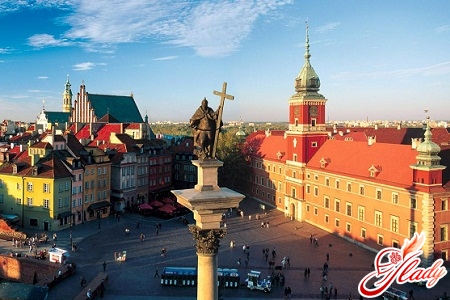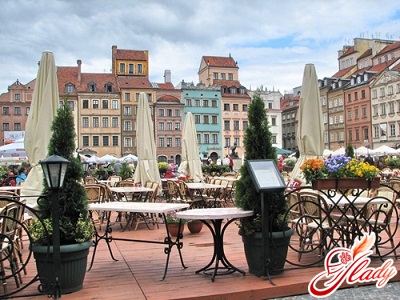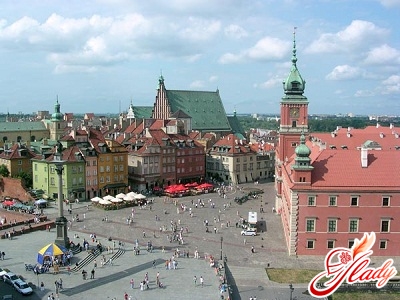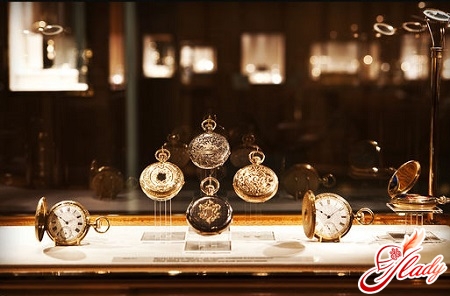 Perhaps one of the most beautiful cities in Europe— this is Warsaw. The sights of the Old Town, lovingly restored by the Poles after the war, are under the protection of UNESCO. Not everyone knows that modern "old" Warsaw is only a few decades old - during World War II, the historical center of the city was almost completely destroyed. However, the Poles are very careful about their history. Almost all the sights in Warsaw and its medieval buildings were restored according to old drawings with amazing accuracy. Therefore, oddly enough, the current appearance of the city even more closely matches the ideas of the 17th century architects than it was before the war. In the Old Town, you can't shake the feeling that its houses and streets are already several hundred years old. There is one legend about the origin of Warsaw. The young prince Casimir went hunting and, carried away by the pursuit of an animal, got lost. He wandered for a long time until he finally came to a tiny fisherman's hut on the banks of the Vistula. Entering the house, he saw a poor fisherwoman who had recently given birth to twins. The boy was called Varsh, and the girl - Sava. In gratitude for the hospitality, the prince rewarded the fisherman's family and became the godfather of his children. With the money he received from the prince, the fisherman built a new large house. Then other fishermen began to settle nearby. A settlement arose, named in honor of the fisherman's children. Over time, it became a city. The first mentions of the city are found in chronicles from the end of the 4th century.
Perhaps one of the most beautiful cities in Europe— this is Warsaw. The sights of the Old Town, lovingly restored by the Poles after the war, are under the protection of UNESCO. Not everyone knows that modern "old" Warsaw is only a few decades old - during World War II, the historical center of the city was almost completely destroyed. However, the Poles are very careful about their history. Almost all the sights in Warsaw and its medieval buildings were restored according to old drawings with amazing accuracy. Therefore, oddly enough, the current appearance of the city even more closely matches the ideas of the 17th century architects than it was before the war. In the Old Town, you can't shake the feeling that its houses and streets are already several hundred years old. There is one legend about the origin of Warsaw. The young prince Casimir went hunting and, carried away by the pursuit of an animal, got lost. He wandered for a long time until he finally came to a tiny fisherman's hut on the banks of the Vistula. Entering the house, he saw a poor fisherwoman who had recently given birth to twins. The boy was called Varsh, and the girl - Sava. In gratitude for the hospitality, the prince rewarded the fisherman's family and became the godfather of his children. With the money he received from the prince, the fisherman built a new large house. Then other fishermen began to settle nearby. A settlement arose, named in honor of the fisherman's children. Over time, it became a city. The first mentions of the city are found in chronicles from the end of the 4th century.
Castle Square
Sightseeing in Warsawrecommend from the Castle Square of the Old Town. It is always noisy and crowded here. A visit to the square is included in all excursion programs. Concerts, folk festivals and other interesting events are often held here. One of the oldest monuments in Warsaw is located on the square - the Column of Sigismund III Vasa. The marble column was erected in 1644 by order of King Władysław IV in memory of his father. The bronze statue of Sigismund III looks down on the Castle Square from a height of 30 meters. In the hands of the monarch - a sabre and a cross. There is a legend that if the old king drops the sabre from his hands, then misfortune and destruction await the city. In 1944, during the uprising, the monument was destroyed. After the war, the statue of Sigismund was restored and installed on a new granite column.
Royal Castle
One of the main attractions of the CastleWarsaw Square - the Royal Palace. The construction of the castle began in the 4th century with the construction of the Great Tower. Later, a wooden fortress was built around it. In the 16th century, King Sigismund III decided to move the capital from Krakow to Warsaw. He settled in the fortress and made it the Official Royal Residence. Over time, a stone palace of an unusual pentagonal shape grew on the site of the old wooden buildings. It is generally accepted that any "self-respecting" old castle should have at least one ghost. The Warsaw Royal Palace is no exception. Back in the 17th century, in the palace chambers, Sigismund Augustus saw the ghost of his dead wife Barbara. King Stanislaw Poniatowski also met the "white lady" twice. According to legend, their first "date" took place in 1772. Then the ghost predicted the first partition of Poland. The second meeting took place in 1794. At that time, the troops of Alexander Suvorov stormed the outskirts of Warsaw. A white shadow appeared in one of the palace windows and predicted the collapse of Poland and the imminent death of the monarch. The Royal Castle was not ignored by alchemists either. During the reign of Augustus II of Saxony, the famous alchemist Jan Böttger unsuccessfully tried to make gold in the palace laboratories. During World War II, the castle, like other Warsaw landmarks, was blown up by German soldiers. Its restoration began only in 1970. Fragments of miraculously surviving wood carvings, stonework, plaster and wall paintings were carefully and tenderly installed into the rebuilt walls.
St. John's Cathedral
Walking along Świętojański Street in the depthsDon't forget to look around the Old Town. Otherwise, you'll miss a lot of interesting things. On the right side is the oldest church in Warsaw - St. John's Cathedral. It was here that the king tried the Teutonic Knights. Stanisław Leszczynski and Stanisław August Poniatowski were crowned here. Tadeusz Kosciuszko prayed in the church and Piotr Skarga preached. A huge wooden crucifix is kept here - an amazing monument of Gothic architecture. It was taken from Nuremberg by a Warsaw merchant in the 16th century, when Germany was engulfed in the Reformation. Otherwise, it would have been destroyed along with other wooden sculptures. Polish kings knelt before this crucifix, which became a national shrine, going into a decisive battle. The crypt of the cathedral is considered the most honorable burial vault in Warsaw. The remains of several generations of Mazovian princes are buried here. The first Polish president Gabriel Narutowicz and the famous writer Henryk Sienkiewicz are also buried there. By the way, don't forget to go to the famous "magic" bell - it is also one of the attractions in Warsaw. It is installed near the cathedral. They say that if you put your hand on it, make a wish, and then walk around it three times - clockwise! - the wish will certainly come true. Next to St. John's Cathedral is the Church of the Jesuit Fathers, built in the Renaissance style. However, it is quite easy to find - the top is visible right from the Castle Square. The temple was built in the 17th century by Sigismund III, dedicating it to the patroness of the city - the Holy Immaculate Virgin Mary.
Market Square
Not far from the Castle, surrounded by houses with narrowfacades, is the Market Square. Once upon a time, wealthy citizens lived here. The buildings look very bizarre - each owner tried to make his house different from the neighboring ones. Therefore, their facades are painted in different colors, and many are decorated with bas-reliefs, paintings or sculptures. Before they came up with house numbers, the Poles gave them names. As a rule, this name reflected the features of the house - "House under the Lion", "House under the Ship", "House under the Pelican", etc. The Market Square in Warsaw is one of the main attractions and the most favorite place for tourists. And the residents themselves love to walk here. Street artists and musicians, cozy cafes, small shops, cabbies waiting for passengers - all this seems to have been taken from the Middle Ages. A walk around the Market Square allows you to stop for a while, take a breather and, at least for a while, escape from the hustle and bustle of another, modern Warsaw.
Siren
Once you get to the Market Square, you need to"meet" the ancient patroness of the city - Siren. They say that once upon a time, curiosity brought a young mermaid to the waters of the Vistula. Fishermen were enchanted by her, and she fell in love with these simple and kind people and sang them her beautiful songs with pleasure. One day, a merchant learned of the mermaid's existence and decided to make money on her magical voice. He caught Siren, put her in a cage and forced her to sing, collecting money for the performance. But the fishermen came to the aid of the mermaid and freed her. In gratitude for this, Siren promised to protect Warsaw from all troubles. Now the warlike mermaid with a sword and shield is a symbol and one of the main attractions of Warsaw. Her figure is depicted on the coat of arms, and a monument is erected on the Market Square.
Historical Museum of Warsaw
The Historical Museum is also located on Rynoksquare. If you have some free time - definitely go there! You will be shown an amazing documentary about the devastation that was Warsaw after the end of the war and the slow, painstaking restoration of the city. Once you go outside, you will see the Old Town with different eyes.
The executioner's house
You can walk along the street Narrow Duna to Podvale.Nearby is the old executioner's house. Once upon a time, the attractions of this area of Warsaw were brothels. They were "managed" by the city's "executioner". He willingly "gave work" to young women, receiving a good additional income. Now the house houses the restaurant "Maharaja".
Monument to the Little Rebel
There is a monument not far from the executioner's houseTo the Little Rebel. The monument was unveiled in 1983. It was dedicated to all the young heroes of the Warsaw Uprising of 1944. The sculpture looks very touching - on the pedestal stands a small, fragile figure of a child of four or five years old. In his hands, the child holds a machine gun, and on his head is an oversized helmet that slides down onto his forehead. It is believed that the monument had a real prototype. The child is the son of a doctor who helped the Resistance fighters. Like many children, he was a liaison between the units. The fighters gave him the nickname "Curly". Like most of the rebels, the child died.
Old Town streets
The streets of old Warsaw are very similar to their ownThe closest neighbors are the streets of Tallinn, Vilnius and Riga. Narrow and winding, they are perfect for a leisurely stroll. The smallest street in Warsaw is called the Stone Steps. It leads to the Vistula. The steps themselves are over 200 years old. At the entrance to the Market Square, Świętojańskiego Street runs into the small Zapeczek Street. Birds were once sold there. Now Zapeczek is interesting because a slab has been walled up in its sidewalk, stating that the Old Town is a monument of world culture. Further, Zapeczek flows into Piekarska. It leads to the fortress wall. Executions used to take place there. The highest point of the Old Town is located on Cielna Street. An unusual observation deck is located here. It is called, not at all romantically, Gnojna Gora. This name is no coincidence - in the Middle Ages, this place was an ordinary city dump. Garbage from the Old Town was brought here. However, that was a long time ago. And the view of the Vistula is amazingly beautiful! You can finish your walk around the Old Town on this platform. Are you tired? Well, after seeing all the sights, you can stop by with a clear conscience in some nice cafe - there are so many of them on the streets of Old Warsaw. The cuisine in Poland is simply fantastic. However, this is a topic for a separate conversation.







